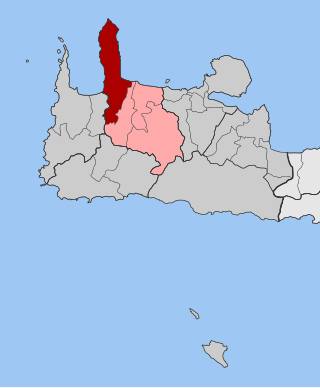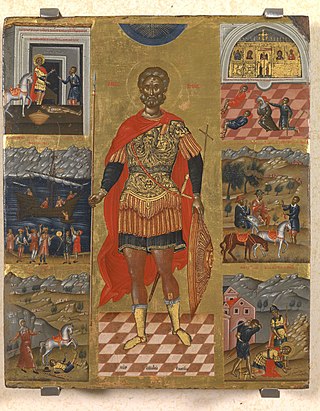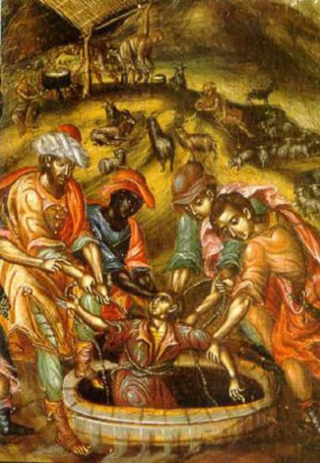Related Research Articles

Crete is the largest and most populous of the Greek islands, the 88th largest island in the world and the fifth largest island in the Mediterranean Sea, after Sicily, Sardinia, Cyprus, and Corsica. Crete rests about 160 km (99 mi) south of the Greek mainland, and about 100 km (62 mi) southwest of Anatolia. Crete has an area of 8,450 km2 (3,260 sq mi) and a coastline of 1,046 km (650 mi). It bounds the southern border of the Aegean Sea, with the Sea of Crete to the north and the Libyan Sea to the south. Crete covers 260 km from west to east but is narrow from north to south, spanning three longitudes but only half a latitude.
The University of Crete is a multi-disciplinary, research-oriented institution in Crete, Greece, located in the cities of Rethymno and Heraklion, and one of the country's most academically acclaimed and reputable universities.

Kolymvari, also known as Kolymbari, is a coastal town at the southeastern end of the Rodopou peninsula on the Gulf of Chania. Kolymvari was formerly a municipality in the Chania regional unit, Crete, Greece. Since the 2011 local government reform it has been a municipal unit of the municipality Platanias. It was also formerly part of the Kissamos province, which covered the northwest of Chania Prefecture. The municipal unit has an area of 149.99 km2 (57.91 sq mi), including the mostly uninhabited and barren Rodopou peninsula to the west and some villages to the south: Rodopou, Afrata, Vasilopoulo, Spilia, Kares, Episkopi, Vouves, Glossa, Panethimos, Nochia, Deliana, Drakona, Ravdouchas, Kalidonia, and Kamisiana.

Cretan School describes an important school of icon painting, under the umbrella of post-Byzantine art, which flourished while Crete was under Venetian rule during the Late Middle Ages, reaching its climax after the Fall of Constantinople, becoming the central force in Greek painting during the 15th, 16th and 17th centuries. The Cretan artists developed a particular style of painting under the influence of both Eastern and Western artistic traditions and movements; the most famous product of the school, El Greco, was the most successful of the many artists who tried to build a career in Western Europe, and also the one who left the Byzantine style farthest behind him in his later career.
Takis Gonias is a Greek football manager and a former player.

Gonia Monastery, Monastery of Our Lady of Gonia or Monastery of Panagia Hodegetria is an Orthodox monastery located 1 km north of Kolymvari and some 26 km from Chania, on the southeast coast of the Rodopos peninsula in Crete, Greece, overlooking the Gulf of Chania. The monastery was given the same name as Hodegon Monastery in Constantinople. Both were named in honor of the sacred icon painted by Luke the Evanglist. The icon featured the Virgin and Child. It is traditionally called Hodegetria. Some churches adopted the name Madonna of Constantinopli in honor of the Hodegetria icon.

Rethymno is a city in Greece on the island of Crete. It is the capital of Rethymno regional unit, and has a population of more than 30,000 inhabitants.
Myriokefala is a local community of the Rethymno Municipality in the Rethymno of the region of Crete established by Kallikratis reform. Previously, it was part of municipality of Lappa. Capital of the new municipality is Rethymno.
Pavlos Iosif Gyparis was a Hellenic Army officer best known as the commander of the personal guard of Prime Minister Eleftherios Venizelos. He took part in many conflicts, and in 1920 was implicated in the assassination of Ion Dragoumis, a political opponent of Venizelos.

Stephanos Tzangarolas also known as Stephano Tzangarola. He was a Greek painter during the late Cretan Renaissance. He migrated from Crete to the island of Corfu. He is a member of the Heptanese School and the Cretan Renaissance. His contemporaries at the time were Panagiotis Doxaras, Theodore Poulakis and Elias Moskos. His artwork began to reflect the transition of the classical maniera greca of Crete to the more refined style of the Ionian Islands. His style resembles the transition of Gentile da Fabriano and Fra Angelico from the maniera greca to their respective styles. Tzangarolas paintings influenced countless artists both Italian and Greek. Some artists that reflect his style include Spyridon Sperantzas and Georgios Kastrofylakas. His paintings can be found all over Greece mainly Athens and the Ionian Islands. Some of his work is in Cairo and London. His student was famous Greek painter Andreas Karantinos.

Emmanuel Skordilis, also known as Emmanouil Skordilis. He was a Greek Renaissance painter. He was active in Crete around the time Emmanuel Tzanes, Elias Moskos, and Philotheos Skoufos were painting in Crete. He belongs to the elite group of Greek painters that followed the Venetian influenced maniera greca in Crete. Sixty eight of his works survived. He is one of few artists to not travel to the Ionian Islands and participate in the Heptanese School. He eventually settled in the Cyclades on the inland of Milos. Christodoulos Kalergis is another prominent Greek artist associated with the Cyclades, he was from Mykonos. Skordilis was influenced by Georgios Klontzas, Michael Damaskinos and Angelos. Skordilis brought the artistic style of Crete to the Cyclades and influenced countless artists in that region.

Georgios Kastrofylakas (Greek: Γεώργιος Καστροφύλακας, 1699/1705 – 1760/1770), also known as Georgios Kastrofylax or (Zorzis). He is one of the few Greek painters that remained in Crete. Others included Ioannis Kornaros. Kornaros was his student. Kastrofylakas followed the lines of the Cretan School. His work was influenced by legendary artists such as Georgios Klontzas, Michael Damaskinos and Angelos. Historians argue Kastrofylakas had many students due to the resemblance of his work. He belongs to the Neo-Hellenikos Diafotismos in painting and the Greek Rococo period. He influenced countless Greek iconographers. Thirty-six paintings are attributed to Kastrofylakas. The artist added more realism to his paintings. Most of his artwork is in Heraklion, Crete. His most notable work is the Adoration of the Magi.

Ieremias Palladas, also known as PouladasIeremia Pallada. He was a Greek Renaissance painter. He was a clergyman, painter, and educator. He was affiliated with Saint Catherine's Monastery in Mount Sinai, Egypt. He is one of the most notable Greek painters of the 17th century. His family consisted of clergy and painters. His nephew was Patriarch of Alexandria Gerasimos Palladas. His work was influenced by Nikolaos Tzafouris and Angelos Akotantos. Georgios Klontzas and Emmanuel Lambardos were active in Crete around the same period. Palladas influenced the works of Theocharis Silvestros, Iakovos Moskos, Ioannis Kornaros and Philotheos Skoufos. According to the Institute of Neohellenic Research, twenty-four of his works survived. His specialty was painting crosses for the iconostasis or templo. Most of his works are in Egypt.

Konstantinos Paleokapas was a Greek painter active during the 17th century. He was active in Crete. His contemporaries were: Elias Moskos, Leos Moskos, Victor (iconographer), Franghias Kavertzas and Ieremias Palladas. His style was similar to his contemporaries, the artists were part of the Cretan School. The art was heavily influenced by Venetian art. His remaining work testifies to the style of the region. Six of his works have survived. His most notable work is the Crucifixion of Christ. His Crucifixion is comparable to the Ioannis Moskos Crucifixion and The Crucifixion (Pavias) by Andreas Pavias. His Crucifixion lacks the unique Impenitent thief found in many followers of Pavias's style. His Crucifixion mostly resembles Ioannis Moskos. Paleokapas had a unique style. Most of his work is at the Gonia Monastery in Crete.

Neilos, also known as Neilos Kokolitza was a Greek painter, monk, and archbishop. He was the Archbishop of Kea and Thira. He was a prominent member of the Cretan School. His contemporaries at the time were Ieremias Palladas, and Theocharis Silvestros. He influenced the works of countless Greek and Italian artists. He is one of few Greek painters who had a high rank within the church. Another hi ranking Greek painter was Archpresbyter Andreas Karantinos. Several of his works have survived and they can be found in the museum of Gonia Monastery. His most popular work is The Story of Joseph.

Georgios Nomikos was a Greek painter. He converted to Christianity from Judaism. He was a Greek Baroque painter. He was a member of the Cretan School and the Heptanese School. His contemporaries were Georgios Kastrofylakas, Theodore Poulakis, and Georgios Markou. He shared the same last name with famous Greek painter Demetrios Nomikos. He was active on the island of Zakynthos, Kefalonia Arta and Ioannina. Six of his paintings survived. Some of his frescos have survived in the destroyed church of Saint George in Lingiades, Ioannina. His work represents an evolution from the art of Angelos Akotantos and Elias Moskos to a more refined technique influenced by the art of the Ionion Islands.

The Crucifixion is a tempera painting by Konstantinos Paleokapas. Paleokapas was a Greek painter from the island of Crete. He was active during the early part of the 1600s. Six of his works survived, four are signed. The Crucifixion is one of the most popular events in human history. The scene has been duplicated countless times. Many crucifixion paintings were created by painters from the island of Crete. Some painters included El Greco, Andreas Pavias, Georgios Markazinis and Ioannis Moskos. Paleokapas created his own version of the popular subject. His crucifixion painting followed the prototype of many other paintings thematically. He added both the dice players and the resurrection of the dead. Andreas Pavias’s The Crucifixion (Pavias) and Margkazinis’s The Crucifixion (Margkazinis) both feature the popular pictorial representation of Mathews gospel. Paleokapas’s Crucifixion is located at the Gonia Monastery in Crete.

The Neradje Mosque or Neradjes, formerly known as Gazi Hüseyin Pasha Mosque is a historical Ottoman-era mosque located in the old town of Rethymno, Crete, Greece. It now serves as a music school.

The Kara Musa Pasha Mosque is a historical Ottoman mosque in the town of Rethymno, on the island of Crete, Greece.
References
- ↑ "Museum of the Monastery of Gonia". Greek Travel Pages. January 2011. Retrieved 2 July 2021.